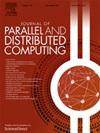基于FPGA的算法与架构协同设计的动态冗余感知视觉变压器加速器
IF 3.4
3区 计算机科学
Q1 COMPUTER SCIENCE, THEORY & METHODS
引用次数: 0
摘要
多模态人工智能(MAI)由于能够处理和集成来自多种模态的数据(包括图像、文本和音频)而引起了人们的极大兴趣。在分布式系统中处理MAI任务需要健壮和高效的体系结构。在这种情况下,Transformer体系结构已经成为主要的网络。在多模态框架中集成视觉转换器(ViTs)对于增强跨不同模态图像数据的处理和理解至关重要。然而,ViTs复杂的体系结构和处理大规模图像数据所需的大量资源对计算和存储提出了很高的要求。这些需求对于在分布式框架内的边缘设备上部署vit尤其具有挑战性。为了解决这个问题,我们提出了一种新的基于并行计算的动态冗余感知ViT加速器,称为DRViT。DRViT由算法和架构协同设计支持。我们首先提出了一种硬件友好的轻量级算法,该算法具有令牌合并、令牌修剪和INT8量化方案。然后,我们设计了一个专门的架构来支持该算法,将轻量级算法转化为显著的延迟和能效改进。我们的设计是在Xilinx Alveo U250上实现的,在140 MHz和100 MHz的viti -tiny下,每个图像的总体推理延迟分别为0.86 ms和1.17 ms。吞吐量峰值可达1,380 GOP/s,即使在较低的频率下,与最先进的加速器相比,也表现出卓越的性能。本文章由计算机程序翻译,如有差异,请以英文原文为准。
DRViT: A dynamic redundancy-aware vision transformer accelerator via algorithm and architecture co-design on FPGA
The multi-modal artificial intelligence (MAI) has attracted significant interest due to its capability to process and integrate data from multiple modalities, including images, text, and audio. Addressing MAI tasks in distributed systems necessitate robust and efficient architectures. The Transformer architecture has emerged as a primary network in this context. The integration of Vision Transformers (ViTs) within multimodal frameworks is crucial for enhancing the processing and comprehension of image data across diverse modalities. However, the complex architecture of ViTs and the extensive resources required for processing large-scale image data pose high computational and storage demands. These demands are particularly challenging for deploying ViTs on edge devices within distributed frameworks. To address this issue, we propose a novel dynamic redundancy-aware ViT accelerator based on parallel computing, termed DRViT. DRViT is supported by an algorithm and architecture co-design. We first propose a hardware-friendly lightweight algorithm featuring token merging, token pruning, and an INT8 quantization scheme. Then, we design a specialized architecture to support this algorithm, transforming the lightweight algorithm into significant latency and energy-efficiency improvements. Our design is implemented on the Xilinx Alveo U250, achieving an overall inference latency of 0.86 ms and 1.17 ms per image for ViT-tiny at 140 MHz and 100 MHz, respectively. The throughput can reach 1,380 GOP/s at peak, demonstrating superior performance compared to state-of-the-art accelerators, even at lower frequencies.
求助全文
通过发布文献求助,成功后即可免费获取论文全文。
去求助
来源期刊

Journal of Parallel and Distributed Computing
工程技术-计算机:理论方法
CiteScore
10.30
自引率
2.60%
发文量
172
审稿时长
12 months
期刊介绍:
This international journal is directed to researchers, engineers, educators, managers, programmers, and users of computers who have particular interests in parallel processing and/or distributed computing.
The Journal of Parallel and Distributed Computing publishes original research papers and timely review articles on the theory, design, evaluation, and use of parallel and/or distributed computing systems. The journal also features special issues on these topics; again covering the full range from the design to the use of our targeted systems.
 求助内容:
求助内容: 应助结果提醒方式:
应助结果提醒方式:


